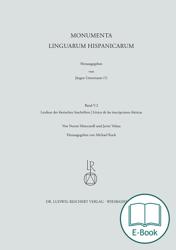Velazas und Moncunills Werk ist die jüngste und umfangreichste Sammlung der antiken Inschriften in iberischer Sprache. Diese Sprache wurde vor einer Generation von Manuel Gómez Moreno lesbar gemacht; sie ist bis heute im Grunde unübersetzt, auch wenn die Forschung zahlreiche Bedeutungen iberischer Worte verstehbar gemacht hat. Umso wichtiger ist die wertende Sammlung aller auf Inschriften der verschiedenen Gattungen anzutreffenden Lexeme dieser Sprache auf dem neuesten Stand der Forschung. Für die vergleichende Sprachwissenschaft auf der Iberischen Halbinsel ist der angezeigte Band, der noch von Jürgen Untermann angeregt wurde, unverzichtbar.
The Iberian language is documented by a rich epigraphic corpus of some 2,300 inscriptions on different materials covering a period of more than five centuries (late 5th century BCE to 1st century CE) and a vast territory of the Mediterranean basin, from southern France to eastern Andalusia. It is currently the most intensively attested amongst the so-called « Palaeohispanic languages », that is the local languages spoken in the Iberian Peninsula before Latin became widespread. Although our knowledge of Iberian has increased substantially in recent years, the language still remains largely undeciphered: in the current state of the art, we are able to read the inscriptions and interpret the meaning of the most formulaic of them thanks to criteria of epigraphic typology and the identification of personal names, but longer texts remain in most cases obscure. Given the scarcity of bilingual inscriptions and the difficulties in finding linguistic cognates, the method of analysis that is usually applied is that of internal combinatory comparison, as developed in Jürgen Untermann’s works.
This new volume in the Monumenta Linguarum Hispanicarum series (MLH V.2), written by N. Moncunill and J. Velaza, provides an annotated glossary of the Iberian language as known through its epigraphic corpus. Although inserted in its corresponding place of MLH, this work reflects the state of knowledge of the Iberian language and its epigraphic culture at the time of its publication. This is the reason why it not only includes the inscriptions collected in the first three volumes of MLH - namely, those devoted respectively to the monetary legends (MLH I), the Iberian inscriptions of southern France (MLH II) and the Iberian inscriptions of Spanish territory (MLH III) - but also incorporates the texts found subsequently, until 2015.
Noemí Moncunill (PhD in Latin Philology) is a « Ramón y Cajal » researcher and lecturer at the University of Barcelona, Classics Department. She has previously been a postdoctoral fellow in different European universities (e.g. Paris Sorbonne, King’s College London, Oxford-CSAD). She is a member of the LITTERA Group and the Hesperia Datablank of Palaeohispanic Languages project.
Javier Velaza (PhD in Latin Philology) is professor of Latin Philology at the University of Barcelona. He is the Director of the research team LITTERA (Laboratory for research and treatment of Roman and ancient Epigraphic texts). He is a member of the Committee of the new edition of the Corpus Inscriptionum Latinarum II (Hispania) and of the International Commitee of Palaeohispanistic.


 Vorwort
Vorwort